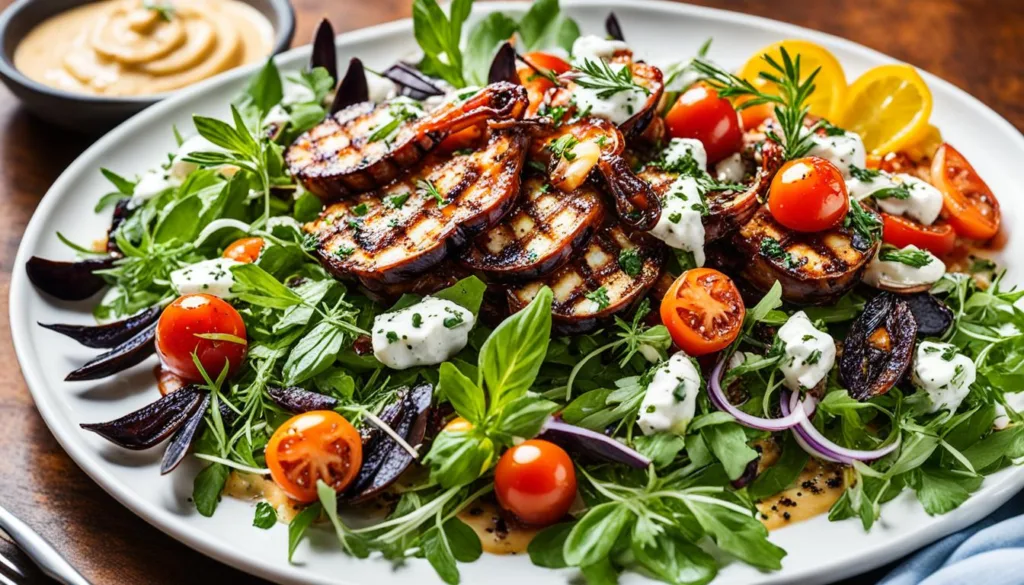Did you know that the famous Greek Feta cheese has been made in Greece for over 6,000 years? This delectable ingredient is just one testament to the timeless traditions and Authentic Greek flavors encountered on a Greek Cuisine Exploration. Greek cuisine is a storied collection of vibrant flavors, representing a treasure trove for foodies and culture enthusiasts alike. A true Greek dining adventure is about more than just savoring mouth-watering specialties; it’s a pathway to encounter the history, community, and the diverse dishes of Greece that have captivated palates the world over. Prepare to embark on a tantalizing journey through a world where the Mediterranean breeze mingles with the aroma of olive oil and oregano, setting the stage for an unforgettable culinary journey.
Key Takeaways
- Explore the ancient roots and modern expressions of Greek Cuisine Exploration.
- Discover regional specialties and communal delights in a Greek dining adventure.
- Savor the blend of fresh ingredients and Authentic Greek flavors that define the nation’s palate.
- Experience the unity of food, culture, and history in each dish throughout your culinary journeys.
- Uncover the culinary secrets behind the diverse dishes of Greece, from the mountains to the islands.
The Cultural Tapestry of Greek Cuisine
Greek cuisine presents more than just a feast for the palate; it is an interwoven part of the country’s culture that prioritizes communal dining, celebrates seasonal produce, and reveres a Greek dietary heritage steeped in tradition. This section explores how these elements come together to create a dining experience that extends beyond the table to the very heart of Greek society.
Communal Dining: A Pillar of Greek Society
The concept of eating as a social event is fundamental in Greece, where sharing traditional Greek recipes amongst friends and family is an act of togetherness. Long tables, the clinking of glasses, and the sound of laughter are as integral to a Greek meal as the food itself, fostering connection and the tradition of storytelling.
Seasonal Produce at the Heart of Greek Cooking
In Greece, the rhythm of the seasons dictates what appears on the dinner table. A walk through any local market reveals an abundance of vibrant seasonal produce, from sun-ripened tomatoes to crisp cucumbers and plump olives, each playing their starring role in various Greek meal ideas.
- Fresh Summer Tomatoes in Horiatiki Salata (Greek Village Salad)
- Wild Spring Greens for Horta Vrasta (Boiled Leafy Greens)
- Autumn Fruits for Spoon Sweets and Preserves
- Winter Citrus for Hearty Stews and Braises
Ministry of Foreign Affairs on Greek Dietary Heritage
According to the Ministry of Foreign Affairs, the quintessential Greek Mediterranean diet represents a lifestyle synonymous with longevity and wellness. It blends the use of fresh ingredients with a shared sense of community, making Greek dietary heritage a treasured pillar of health and social vitality.
| Mediterranean Diet Component | Health Benefit | Place in Greek Culture |
|---|---|---|
| Olive Oil | Rich in Monounsaturated Fats | Essential in Cooking and Dressings |
| Legumes | Source of Plant-based Protein | Base for Traditional Dishes like Fasolada |
| Seafood | High in Omega-3 Fatty Acids | Abundant in Coastal Regions |
| Fresh Vegetables | Loaded with Vitamins, Minerals, and Fibers | Daily Staples in Greek Cuisine |
A Feast for the Senses: The Art of Greek Mezes
Gathering around a table filled with Greek mezes is more than just a meal—it’s an invitation to participate in a cultural tradition that celebrates taste, texture, and communal delight. Integral to any Mediterranean cuisine exploration are these small dishes, each one a tiny tribute to Greece’s culinary diversity. Let us delve into the vibrant world of Greek mezes and discover why they hold such a revered spot in the hearts of food connoisseurs.
Exploring Tzatziki and Taramasalata
Two pillars of the Greek meze platter are Tzatziki and Taramasalata. Tzatziki, a creamy and refreshing combination of yogurt, cucumber, garlic, and dill, is more than a mere condiment—it’s a versatile companion to any dish, spread, or dip you can dream up. Taramasalata, with its delicate pink hue, indulges the palate with a rich blend of fish roe, olive oil, lemon juice, and starchy base, making it a flavorful spread over warm, freshly baked pita bread.
Savoring Spinach and Feta in Spanakopita
The layers of crispy, golden phyllo pastry in Spanakopita, filled with a satisfying mixture of spinach and feta, reveal the hearty soul of Greek cuisine. Each bite of this savory pie whispers stories of homes and hearths where grandmothers and chefs alike craft this beloved dish with time-honored techniques, securing its place as a meze that is both humble and sophisticated.
The Regional Twists on Dolmades and Keftedes
Dolmades and Keftedes epically exemplify how local customs can take a basic idea and transform it into a symphony of regional flavors. The tender grape leaves of dolmades, stuffed with herbed rice or meats, can change from one village to the next, while keftedes—juicy meatballs flavored with onion, mint, or oregano—differ in composition and spices, reflecting the very landscape from which they originate.
Greek Cuisine Exploration Through Street Foods
Delving into the bustling streets of Greece, one’s palate is immediately enveloped by the authentic Greek flavors of traditional street food. Greek street foods, such as Souvlaki and Gyro, are not just mere snacks but a vibrant exhibition of Greece’s culinary prowess. These dishes embody the true spirit of Mediterranean flavors, turning a simple walk through Athens or a quiet moment in a village into a full-fledged Greek dining adventure.
To best appreciate the rich variety and cuisine, it’s essential to understand the differences and unifying elements that make these street foods so beloved:
| Dish | Main Ingredients | Origin | Tasting Notes |
|---|---|---|---|
| Souvlaki | Marinated meat, pita bread, tzatziki sauce, tomatoes, onions | Athens and beyond | Marinated in a harmony of herbs and spices, Souvlaki boasts smokey charred edges that complement the cool, creamy tzatziki. |
| Gyro | Rotisserie meat, pita bread, tzatziki sauce, lettuce, tomatoes, onions | Originated in Greece, inspired by similar dishes from neighbouring regions | A perfect blend of crisp vegetables and juicy, well-seasoned meat creates a satisfying, flavor-packed bite each time. |
Whether you grab a warm, foil-wrapped delight from a street vendor or take a moment to savor your bite at a breezy outdoor cafe, these street foods are accessible indulgences for all to enjoy. Their universal appeal lies in the high-quality local produce—the ripe tomatoes, the crisp onions, and the luscious, locally made yogurt that forms the tzatziki’s base. It’s a testament to the fact that Greece’s culinary tradition is alive and celebrated daily on the streets, bringing together locals and tourists alike in a shared love for good food.
- ***Souvlaki***: Skewered and grilled heaven, Souvlaki is an embodiment of simple elements brought to new heights.
- ***Gyro***: The spinning sensation known as Gyro invites a cacophony of flavors, wrapped up in a soft pita—a handheld marvel.
These iconic eats are humble yet bold, offering a bite of Greek heritage with each mouthful. As we journey through the array of Greek street foods, we embrace the casual culinary culture that makes Greece a gastronomic landmark.
Seafood: A Mediterranean Journey
Embark on a Mediterranean journey where the Greek seascape unfolds into a tableau of exquisite Greek seafood. From the caress of the gentle Mediterranean breeze to the subtle dance of the waves, Greece’s shoreline invites diners to a culinary experience that epitomizes freshness and tradition. Picture a rustic table at a coastal taverna, adorned with regional delights that tell the story of the Greek sea—each catch more tempting than the last.

One cannot speak of Greek seafood without the mention of the venerable grilled octopus. Revered for its tender flesh and smoky flavor, octopus gracing the grill is an image synonymous with Greece’s culinary identity. As part of this rich Greek seaside tradition, dishes such as sea bass and red snapper follow, expertly cooked to enhance their inherent sweetness and delicate texture. It’s in these bites that the simplicity of the grilling technique pays homage to the sea’s natural bounty.
And who could overlook the heritage-rich Kakavia? This traditional fisherman’s soup weaves a pot of vibrant local catch, from crustaceans to mollusks, with a medley of garden vegetables and aromatic herbs. Its heartwarming essence captures the true essence of Greek family gatherings, reinforcing the timeless bond between the sea and Greek culture.
| A Taste of the Aegean: Greek Seafood Classics | |
|---|---|
| Dish | Description |
| Grilled Octopus | Charred to perfection, the octopus is served with a drizzle of olive oil and a splash of lemon. |
| Sea Bass | Often grilled or baked, the white, flaky sea bass is seasoned with local herbs for a mild, refined flavor. |
| Red Snapper | Rich in flavor, the red snapper is typically cooked whole, often steamed or grilled with rosemary. |
| Kakavia | Kakavia, a luscious soup, brims with various seafood and merges flavors of earth and ocean in a harmonious blend. |
Partaking in a sumptuous spread of Greek seafood is more than a meal; it is participation in a Mediterranean journey that’s been navigated for millennia. The marine gastronomy of Greece—encompassing everything from grilled octopus to hearty Kakavia—is a manifestation of a culinary heritage as deep and vast as the blue waters itself.
Savoring Regional Delights: From Cretan Lamb to Thessaloniki Bougatsa
Greece is celebrated for its Regional Greek delicacies, each offering a unique culinary journey through the country’s local traditions and flavors. As you traverse the rolling hills of Crete, the allure of perfectly roasted Cretan lamb speaks to the soul of Mediterranean cooking. Over in Thessaloniki, the morning air is sweetened by the scent of Thessaloniki Bougatsa, a delightful pastry that is a testament to the ingenuity of Greek baking.
In every bite of these regional specialties, there lies a story of place and people. Notable among them are the famed Domatokeftedes from the sun-kissed island of Santorini. These tomato fritters, seasoned with local herbs, showcase the island’s renowned cherry tomatoes, offering a taste as vibrant as the Santorini sunset.
- Cretan Lamb – The epitome of Cretan culinary excellence, this succulent and herby dish is marinated with local ingredients before slow-roasting to perfection.
- Thessaloniki Bougatsa – Experience layers of crispy phyllo pastry enveloping creamy custard or savory cheese fillings, an essential morning treat in Thessaloniki’s bustling streets.
- Domatokeftedes (Santorini Tomato Fritters) – A flavorful amalgam of Santorini tomatoes, onions, and fresh herbs, fried to achieve the perfect golden crisp exterior while remaining tender inside.
These artisanal delights not only recount the rich history of Greek gastronomy but also embody the heart and soul of regional craftsmanship. When tasting these dishes, one immerses in the storied past and spirited life of the Greek people – a narrative told through the universal language of exquisite food.
Decoding Greek Sweets: From Baklava to Loukoumades
The sweet culmination of any Greek dining adventure brings to the forefront a decadent array of Greek desserts that are as rich in flavor as they are in cultural significance. Beyond savory delights, Greece’s pastry shops and home kitchens alike brim with classic confections, from the honeyed spirals of Baklava to the airy, honey-soaked puffs known as Loukoumades. A voyage through sweet Mediterranean cuisine exploration is incomplete without sampling these epitomes of sugary bliss. Let’s unwrap the sweet legacy of these treasures that have sweetened Greek tables for generations.
Indulging in Syrupy Greek Spoon Sweets
Delving deeper into the heart of Greek spoon sweets, we discover a symphony of fruit and syrup concocted to capture the ephemeral bliss of summer’s bounty. These spoonfuls of joy are traditionally served to guests as a gesture of hospitality, revealing the essence of Greek conviviality. Displaying an array of fruits from bergamot to cherry and even the delicate rose petal, spoon sweets are not solely a dessert but a sweet token of Greek generosity.
Understanding the Layers of Baklava
The craftsmanship of baking Baklava is a testament to the culinary artistry passed down through ages. Witnessing its multiple luscious layers of finely wrought phyllo pastry intermingled with spiced nuts and sealed with sweet syrup whisks one away on a delectable voyage through history and taste. This beloved Greek dessert exemplifies tradition and innovation, with local variations adding their unique twist to this already perfect pastry.

Greece’s Vineyards and Spirits: A Toast to Tradition
Greece offers an exquisite Greek dining adventure that extends beyond its delectable cuisine and into the realm of sumptuous wines and spirits. Enthusiasts are invited to explore sprawling Greek vineyards, which produce a diverse array of wines that range from the robust reds harvested in the sun-drenched hills of Nemea to the crisp, volcanic-soil-grown whites such as Assyrtiko from Santorini.
Embodying the spirit of the Mediterranean, local spirits like Ouzo and Tsipouro stand as pillars of Greek conviviality. A glass of Ouzo, with its anise-flavored allure, evokes the very essence of the Greek social tapestry, while Tsipouro, often shared among friends, signifies the bonds that hold together Greek culture.
- Nemea Vineyards: Known for the Agiorgitiko grape, producing wines with depth and rich color.
- Assyrtiko of Santorini: Famed for its mineral complexity and citrus notes, reflecting the unique terroir of the island.
- Ouzo: An emblematic aperitif that complements an array of mezze dishes, enhancing the Greek dining experience.
- Tsipouro: A bold spirit traditionally sipped alongside small plates or during special occasions.
A visit to these storied locales is not just a tasting experience; it is a passage through history, capturing the resilience and passion of Greek winemakers. To partake in a glass from these hallowed grounds is to toast to a tradition as timeless and cherished as Greece itself.
The Lure of Land and Sea: Foundations of Greek Cuisine’s Freshness
Enveloped by the shimmering Aegean and Ionian Seas, Greek cooking traditions have long been shaped by the bountiful gifts of both land and sea. It is here, within this terrain, that the freshest ingredients are harnessed to create the distinctive flavors of Mediterranean cuisine. These ingredients are not just food; they are a testament to the Greek way of life, merging sustenance with the art of celebration.

From Mountainous Terrain to Bountiful Coasts
The contrast of rugged highlands against expansive coasts allows Greek cuisine to enjoy a vast spectrum of natural produce. From the peaks where wild herbs and mountainous cheese pies reign, to the shores that yield the freshest of seafood, the influence of Greece’s unique topography is undeniable.
Ingredients Shaped by Geography
The regional diversity of Greece is mirrored in its culinary offerings. The dry, arid climate in some areas leads to the cultivation of durable crops like olives, while cooler, moist conditions in others allow for the growth of succulent fruits and vegetables. It is this geographical diversity that has sculpted a menu as varied as the Mediterranean landscape itself, creating an array of dishes that cater to every palate.
The Intertwined History of Influence and Greek Culinary Practices
The Greek culinary experience reflects a rich mosaic of historical influences, with each era contributing distinct flavors and techniques to the tapestry of its cuisine. The long-standing reign of the Ottoman Empire, in particular, introduced a variety of spices and methods, creating a vibrant Mediterranean infusion that still resonates in contemporary Greek dishes.
From the conquests that spread as wide as Persia and Rome to the more prolonged Ottoman occupation, there has always been a cultural exchange that enriched Greek food traditions. Dishes such as baklava and dolmades are quintessential examples of this shared heritage—a blend of Greek inventiveness with an Ottoman flair. This interweaving of culinary stories has not only shaped what is on the plate but has also created a sense of community that defines Greek dining.
Moreover, the food of the Greeks has been influenced not just by empires but also by the humble lifestyles of its people. The nomadic shepherds of the mainland contributed to what is referred to as ‘shepherd’s cuisine.’ Simple, hearty meals making use of available local ingredients such as wild herbs, lamb, and staple dairy products now form the backbone of the rustic Greek mainland culinary scene.
The result is a delicious legacy, a testament to Greece’s ability to absorb and transform external influences into a cuisine that is both unique and inviting. It is through every bite of Greece’s diverse dishes that one can taste the stories of its vibrant, storied past.
The Iconic Staples of the Greek Kitchen
At the heart of Greek cuisine are certain enduring ingredients that define the very essence of Greek food dishes. Famed for their robust flavors and health benefits, these culinary treasures are integral to what is often considered the pillar of the Mediterranean diet. Let’s delve into the staples that no Greek kitchen would be without, and discover why they are cherished not only in Greece but across the globe.
Feta Cheese: Greek Tradition in Every Bite
Feta cheese, the quintessential Greek cheese, carries a legacy steeped in the Mediterranean lifestyle. Acknowledged worldwide for its bold tanginess and signature crumble, feta is a PDO (Protected Designation of Origin) product, ensuring that only cheese produced in a traditional way and in a specific geographic area of Greece can be called ‘feta’. Whether crumbled over a fresh Greek salad or baked into a warm, inviting spanakopita, feta is a true touchstone of Greek tradition.
The Creamy Delight of Greek Yogurt
Another pillar of health and flavor in Greek cooking is Greek yogurt. Known for its rich, creamy texture, this culinary delight is versatile enough to find its way into both savory and sweet dishes. Greek yogurt is an excellent source of calcium and protein and is often associated with numerous digestive health benefits, thanks to its probiotics. Whether served with honey and nuts, or used in crafting a cool, creamy tzatziki, the inclusion of Greek yogurt is a testament to the marriage of taste and nutrition in Greek cuisine.
Olives and Olive Oil: Greek Liquid Gold
Olives and olive oil, praised for their flavor and health properties, are often referred to as ‘Greek liquid gold’, a vital component of the Mediterranean diet. From the Kalamata’s world-famous black olives to the extra virgin olive oil making up the basis of numerous Greek dishes, these ingredients boast anti-inflammatory properties, antioxidants, and heart-healthy monounsaturated fats. Incorporating fresh olives in a mezze platter or drizzling olive oil over a warm slice of crusty bread captures the simple yet profound culinary ethos of Greek living.

| Ingredient | Characteristic | Culinary Uses | Health Benefits |
|---|---|---|---|
| Feta Cheese | Tangy, crumbly | Salads, pies, mezze | Source of calcium, protein |
| Greek Yogurt | Creamy, rich | Dips, desserts, sauces | Probiotics, protein |
| Olives/Olive Oil | Fruity, rich | Cooking, dressings, dips | Monounsaturated fats, antioxidants |
Modern Greek Cuisine: A Blend of Time-Honored Recipes and New Inspirations
The panorama of the Modern Greek cuisine landscape has expanded to include innovative takes on classic traditions, taking the rich Mediterranean culinary heritage to new heights. As food enthusiasts delve into evolved Greek food recipes, they encounter a fusion of cherished customs and contemporary influences. This transformative journey through Greek flavors exemplifies the dynamic nature of cultural gastronomy.
From Shepherd’s Pies to Sea Fare: The Diverse Diets of Greece
The array of Greek dishes spans from the mountainous terrains to the azure coastlines, offering a culinary adventure like no other. The heartiness of a shepherd’s pie, rich in flavors from the land, contrasts with the delicate balance of a maritime diet, making each region’s culinary profile distinct and delectable.
Connecting Cultures Through Greek Flavors
By embracing Greek cuisine, individuals connect with historical roots while exploring contemporary tastes. The shared love for food breaks boundaries, uniting people across the globe through a universal language of flavor indigenous to the Greek gastronomic scene.
| Traditional Recipe | Modern Twist | Cultural Influence |
|---|---|---|
| Moussaka | Deconstructed Moussaka with Eggplant Foam | Ottoman Spice Fusion |
| Souvlaki | Souvlaki Skewers with Avocado Tzatziki | Global Vegan Trend |
| Horiatiki Salad | Horiatiki with Quinoa & Sun-dried Tomatoes | Adoption of Superfoods |
| Galaktoboureko | Galaktoboureko Bites with Citrus Syrup | Miniaturized Desserts Trend |
Conclusion
The journey through the multifaceted panorama of Greek Cuisine Exploration culminates in an enriched understanding of a culture steeped in historical depth and communal joy. This voyage has illuminated the vast mosaic of traditional Greek recipes, giving us a taste of the robust, flavorsome encounters integral to the Greek culinary experience. As we’ve seen, each morsel is a narrative, interwoven with the threads of time-honored traditions and vibrant social gatherings, where every dish transcends sustenance to become a festive occasion.
Embodying the essence of Mediterranean hospitality, Greek food dishes draw on the profound connection between land, sea, and sky – uniting fresh ingredients with the spirited zest of life itself. Greek meal ideas evoke a simple, yet profound, philosophy: sharing food is sharing life. This exploration has invited not just a reconsideration of ingredients and combinations, but an invitation to embrace the communal spirit infused in every savory bite and sweet indulgence.
In final reflection, Greek culinary experience is not merely about satisfying the palate, but rather, it’s about embracing a lifestyle that celebrates gastronomy as a form of art, friendship, and heritage. It’s a reminder that behind every carefully crafted dish is an invitation to partake in a story as old as the olive trees, and as deep as the Aegean Sea. As you carry forth these inspirations into your own kitchen, may the spirit of Greece enhance each homemade creation or dining endeavor, perpetuating a legacy that is as timeless as it is flavorsome.
FAQ
What are some must-try dishes for a Greek cuisine exploration?
For an authentic Greek culinary experience, you should try a variety of dishes ranging from communal mezes like Tzatziki and Taramasalata, street foods such as Souvlaki and Gyro, regional specialties like Cretan lamb or Domatokeftedes from Santorini, and traditional Greek desserts like Baklava and Loukoumades.
How important is communal dining in Greek society?
Communal dining is a pillar of Greek society. It’s considered a time for social gathering and storytelling, further enhancing the enjoyment of the meal. Traditional Greek recipes are often designed to be shared, fostering a sense of community and togetherness.
Can you describe the Greek Mediterranean diet?
The Greek Mediterranean diet is characterized by its use of fresh, seasonal produce, olive oil, grains, fish, and lean meats. It’s not only a way of eating but a lifestyle that promotes communal meals and healthy living, as recognized by the Ministry of Foreign Affairs.
What makes Greek mezes a distinctive aspect of the country’s culinary tradition?
Greek mezes are a feast for the senses, offering a variety of small dishes that showcase a harmony of Mediterranean flavors. They are designed for sharing and are a fundamental part of the Greek dining adventure, providing a lively and interactive way to enjoy a meal.
What types of seafood can I expect to find in Greek cuisine?
Greek cuisine takes full advantage of its extensive coastline, offering a rich variety of seafood dishes. You can savor grilled octopus, fresh sea bass, red snapper, and traditional dishes such as Kakavia, a flavorful fisherman’s soup.
How do Greek desserts reflect the nation’s culinary heritage?
Greek desserts like Baklava, Loukoumades, and Greek spoon sweets are deeply rooted in tradition, often reflecting culinary influences from different historical periods. Each sweet confection tells a story of Greece’s past and is a testament to its rich dessert tradition.
What role do local wines and spirits play in a Greek dining adventure?
Local wines and traditional spirits, such as ouzo and tsipouro, play a central role in Greek dining experiences, often accompanying meals and signifying hospitality and celebration. Greek vineyards, with their diverse climates and terrains, produce a wide range of unique wines that complement the flavors of Greek cuisine.
How does the land and sea influence Greek cooking traditions?
The geography of Greece, including its mountainous regions and surrounding seas, greatly influences the freshness and variety of ingredients used in Greek cooking. The land’s climate and terrain dictate the availability of certain produce and flavors, leading to a rich diversity of dishes across the country.
What makes feta cheese and Greek yogurt integral to Greek cuisine?
Feta cheese and Greek yogurt are integral to Greek cuisine due to their unique textures and nutritional properties. Feta adds a tangy taste to Greek dishes, while Greek yogurt offers a creamy consistency ideal for sauces and desserts. Both are iconic staples that epitomize Greek culinary practices and the Mediterranean diet.
How does modern Greek cuisine balance tradition with innovation?
Modern Greek cuisine maintains a respect for time-honored recipes while embracing new inspirations and trends. Chefs often reinterpret traditional dishes by infusing them with contemporary flavors or techniques, creating a culinary landscape that bridges the gap between Greece’s rich heritage and a modern palate.






